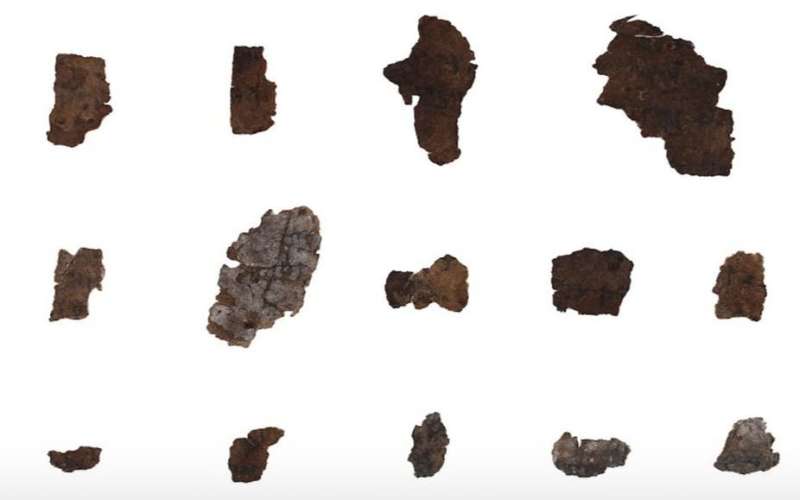Dead Sea Scrolls deciphered: esoteric code reveals ancient priestly calendar

About 1,000 Dead Sea Scrolls discovered just over 70 years ago near Khirbet Qumran on the northwestern shore of the Dead Sea have been officially published since the turn of the millennium. But in the case of some, all that was left were poorly preserved remains of texts written in a cryptic script – and all that had been released to the world were photos of small pieces of manuscript, in a preliminary order. There have been previous attempts to decipher them, though we were left with substantial gaps in our understanding of what they contained.
So the recent story of the publication in the US-based Journal of Biblical Literature of a reconstruction of one of these scrolls by a team of scholars from the University of Haifa, Eshbal Ratzon and Jonathan Ben-Dov, has provoked intense public interest around the world.
The text in question is actually a collection of around 60 poorly preserved pieces, known in the trade as "fragments" – which can be seen in detail here. These fragments, at most, contain parts of three words and often fewer. The text contains parts of a calendar based on a 364-day solar year, which has the benefit of the annual festivals never falling on a Saturday, which would have clashed with the Jewish Sabbath.
This calendar is promoted in a number of Dead Sea Scrolls and was probably used instead of the more widespread approximately 354-day lunar calendar. The Hebrew Bible does not present a clear and complete calendar, which is why ancient Jewish groups debated the issue. The Babylonian calendar was luni-solar comprising 12 lunar months. But the Dead Sea Scrolls also provide evidence of a number of texts that attempt to incorporate both the movements of the sun and the moon into more complex calendars.

The document as reconstructed here also includes a group of fragments that list the names of priestly families to serve in rotating cycles of duty in the Temple at Jerusalem – a practice that is described in the Biblical book of 1 Chronicles 24. We think Chronicles was probably composed in the 4th century BC. Cycles of priestly shifts in the Temple are also referred to in a number of the Dead Sea Scrolls. As there were too many priests to serve concurrently in the sanctuary, Chronicles is the first source that sets out a rota system allowing different priestly families to serve for a week at a time.
A considerable challenge facing scholars working on this particular broken up calendar text is that it is written in a cryptic script. This script was deciphered in the 1970s by the brilliant Polish Dead Sea Scrolls scholar Józef Milik. The alphabetic code draws on a more ancient form of the Hebrew script (paleo-Hebrew) from that predominantly used in the Scrolls – as well as other symbols such as Greek letters.
By far the most substantial challenges faced by Ratzon and Ben-Dov was working out which particular tiny pieces belong to which manuscript and in what sequence. Imagine a jigsaw puzzle with tiny broken pieces, most of them missing, without the benefit of the picture on the box for guidance. In short, Ratzon and Ben-Dov deserve great credit for making rapid progress with this very demanding work.
Cracking the code
The idea of an esoteric code invariably indulges the imagination about secret and potentially explosive knowledge – it's the stuff blockbusting novels are made of. But, as Ratzon and Ben-Dov rightly point out, the kind of material written in this code – including the calendar system in this recently reconstructed text – is well-known from texts written in regular Hebrew script.
The team's explanation for why anyone would pen freely available material in an esoteric script is convincing – they believe it is a means of indicating the prestige of certain scribes. Thus far, the only attestation of this cryptic script outside of Qumran is an inscription on a stone cup discovered during excavations of the priestly quarter in the Old City in Jerusalem in 2009. This led another expert on the cryptic Dead Sea Scrolls, Stephen Pfann, the editor of a number of cryptic texts from Qumran, to associate the script with priestly learning. Priestly concerns such as ritual purity – a striving to separate the holy from the profane rather than conventional cleanliness – are prominent also in the Scrolls and the archaeological remains from the site of Khirbet Qumran.
Given Ratzon and Ben-Dov's expertise in the matter of the technical ancient Jewish calendars – and the fact that the Dead Sea Scrolls included two further documents that preserve traces of a comparable calendar system – have allowed them to make excellent progress on the ordering of these fragments over the course of a year.
While the details of calendrical systems are an acquired taste, these calendars have, once cracked, a habit of being helpfully repetitive. A key piece in the puzzle was the team's recognition that a scribe added additional text in the empty space on the edge of the writing block (the margin) and as he (less likely, she) ran out of space turned the scroll by 90 degrees and continued to write at the bottom of the column with letters that now appear upside down.
Ratzon and Ben-Dov also draw attention to a large number of corrections that address gaps in the text. It seems possible that these "corrections" – a term that implies there was a "correct" text – are, in fact, indications of how ancient scribes drafted texts in sometimes messy ways. So what we may have here is a working copy of calendric material as it was being composed. A first draft of history, in other words.
Provided by The Conversation
This article was originally published on The Conversation. Read the original article.![]()





















